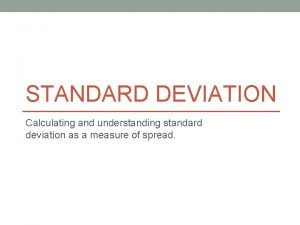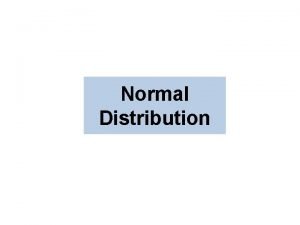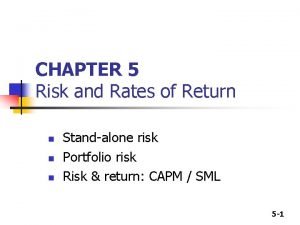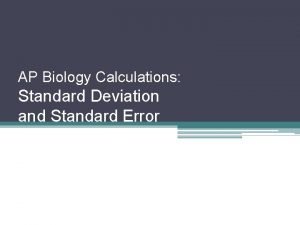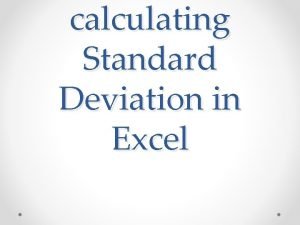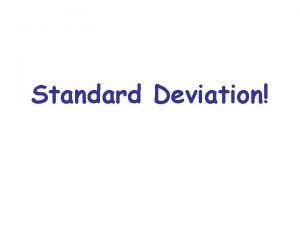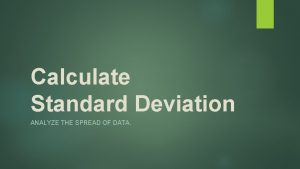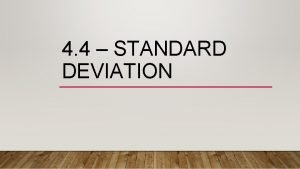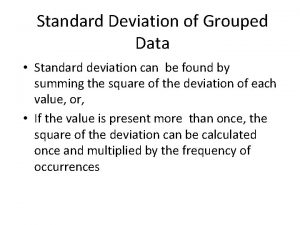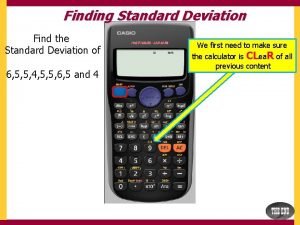Calculate Standard Deviation ANALYZE THE SPREAD OF DATA








- Slides: 8

Calculate Standard Deviation ANALYZE THE SPREAD OF DATA.

Focus 6 Learning Goal – (HS. S-ID. A. 1, HS. S-ID. A. 2, HS. S-ID. A. 3, HS. S-ID. B. 5) = Students will summarize, represent and interpret data on a single count or measurement variable. 4 3 2 1 0 In addition to level 3. 0 and above and beyond what was taught in class, the student may: · Make connection with other concepts in math · Make connection with other content areas. The student will summarize, represent, and interpret data on a single count or measurement variable. - Comparing data includes analyzing center of data (mean/median), interquartile range, shape distribution of a graph, standard deviation and the effect of outliers on the data set. - Read, interpret and write summaries of two-way frequency tables which includes calculating joint, marginal and relative frequencies. The student will be able to: - Make dot plots, histograms, box plots and two-way frequency tables. - Calculate standard deviation. - Identify normal distribution of data (bell curve) and convey what it means. With help from the teacher, the student has partial success with summarizing and interpreting data displayed in a dot plot, histogram, box plot or frequency table. Even with help, the student has no success understanding statistical data.

Standard Deviation is a measure of how spread out numbers are in a data set. It is denoted by σ (sigma). Mean and standard deviation are most frequently used when the distribution of data follows a bell curve (normal distribution).

Formula for Standard Deviation

Calculate the standard deviation of the data set: 60, 56, 58, 60, 61

Measures of Deviation Practice (Each student needs a copy of the activity. )

Measures of Deviation Practice (35 – 60. 71) = -25. 71 661. 00 (50 – 60. 71) = -10. 71 114. 70 (60 – 60. 71) = -0. 71 0. 50 (75 – 60. 71) = 14. 29 204. 20 (65 – 60. 71) = 4. 29 18. 40 (80 – 60. 71) = 19. 29 372. 10 1, 371. 40

Measures of Deviation Practice Explain what the mean and standard deviation mean in the context of the problem. A typical phone at the electronics store costs about $60. 71. However, 68% of the phones will be $15. 12 lower and higher than that price. ($45. 59 – $75. 83)
 Whats the mean absolute deviation
Whats the mean absolute deviation Understanding standard deviation
Understanding standard deviation Calculate standard deviation from mean
Calculate standard deviation from mean Standard deviation of portfolio
Standard deviation of portfolio What is standard deviation in biology
What is standard deviation in biology How to calculate standard deviation in excel 2007
How to calculate standard deviation in excel 2007 How to calculate spread of data
How to calculate spread of data Rumus standar error rata-rata
Rumus standar error rata-rata Formula of assumed mean method
Formula of assumed mean method

